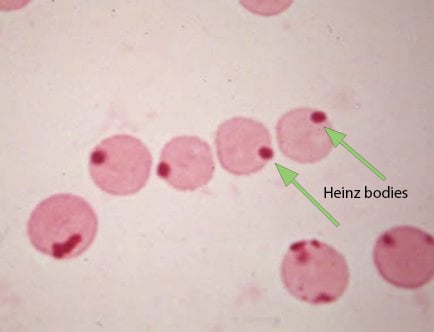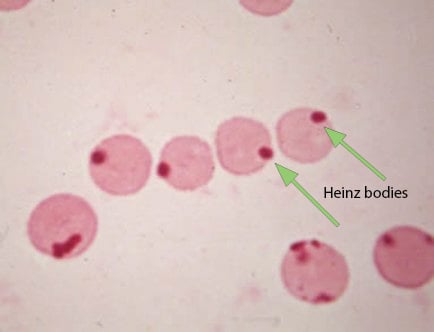Peds Question of the Month: Recognize Evidence of Heinz Bodies

Do you know the answer to this Pediatrics question from our Peds Board-Style Q&A Premium? Q&As are the most important thing to do when you get close to your boards!
Do You Know the Answer To This Pediatrics Hematology Question?
A previously well 4-year-old boy presents to the emergency department with a 2-day history of extreme fatigue and shortness of breath with even minimal physical activity. He appears pale on physical examination.
His hemoglobin is 5.5 g/dL; reticulocyte count is 16%. A peripheral smear stained with supravital stain reveals intracellular inclusions in many red blood cells.
 Heinz bodies
Heinz bodies
Which of the following tests is most likely to confirm the cause of this patient’s clinical and laboratory findings?
A) Measurement of RBC glucose-6-phosphate dehydrogenase activity in 2–3 months
B) Immediate measurement of serum lead and free erythrocyte protoporphyrin
C) Immediate measurement of methemoglobin
D) Measurement of RBC pyruvate kinase activity in 2–3 weeks
E) Immediate measurement of cold-antibody titers
Answer and Explanation
The answer is A. The patient has clinical and laboratory findings consistent with glucose-6-phosphate dehydrogenase (G6PD) deficiency.
This disorder is characterized by hemolysis due to intracellular generation and accumulation of free oxygen radicals and peroxides generated by certain oxidant drugs (e.g., nitrofurantoin, aspirin, and antimalarials). Acute hemolytic episodes and premature red cell destruction may also be induced by infection, diabetic ketoacidosis, and exposure to certain chemicals (e.g., benzene, naphthalene). Ingestion of fava beans (favism) may also result in a hemolytic crisis. Hemoglobin typically precipitates into Heinz bodies, visible on unstained or supravital stained peripheral smears, which also characteristically reveal physical evidence of damage to the red blood cell membrane.
G6PD activity is markedly reduced in patients (~ 10% of normal) with G6PD deficiency. Immediately following a hemolytic episode, younger cells and reticulocytes, which have higher activity, predominate; therefore, measurement of enzyme activity is best delayed by several weeks in order to document a diagnostic decrease in enzyme activity. G6PD synthesis is determined by a gene on the X chromosome; clinically significant disease is therefore more common among males. The incidence of G6PD deficiency is increased in African Americans, and also in those of Mediterranean origin. Therapy is generally supportive but may require blood transfusion. Prior to transfusion, obtain samples of the patient’s blood for additional testing. Full recovery follows removal of the offending agent or treatment of associated infection.
Measurement of methemoglobin levels is appropriate when methemoglobinemia is suspected, such as when hypoxia does not improve with supplemental oxygen therapy or when there has been exposure to a potential oxidative stressor (e.g., benzene).
In cold agglutinin disease, IgM-RBC complex lyse complement and cause intravascular hemolysis. It can occur with Mycoplasma and Epstein-Barr virus infections.
Measurement of serum lead and free erythrocyte protoporphyrin are indicated in cases of suspected lead poisoning.
Measure the red blood cell pyruvate kinase (PK) activity when a PK deficiency is suspected. Symptoms of this disorder include unexplained hemolytic anemia.
What You Need To Know About Heinz Bodies for Peds Boards
Board testing point: Recognize evidence of Heinz bodies on peripheral smear and recall that this finding is consistent with the diagnosis of G6PD deficiency.
Like the way the answer gives you a detailed explanation as to why the correct answer is right and why the incorrect is wrong? Get your Pediatrics Board-Style Q&A Premium now and start self-testing!
See if you know this question about autism screening.


